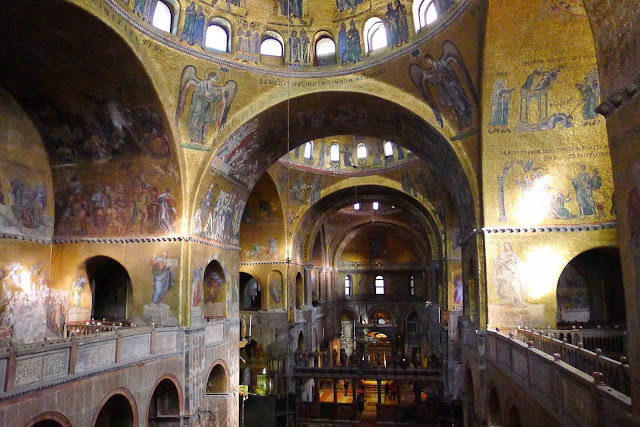Wawel Hill - Castle, Cathedral, and Crypt of the Polish Kings
Following our morning in the Underground Salt Cathedral of Wieliczka, we decided to go the other direction in the afternoon by going uphill to learn more about the Kings and Queens of the Polish people.
Wawel Hill, situated on the banks of the fabled Vistula River, is a castle complex built in the 8th Century serving as the political center of the Polish people for over a millennium. The complex includes the Royal Castle and Wawel Cathedral, which contains the mausoleum of the Polish Monarchs.
* The astounding view of the Wawel Cathedral grounds! The castle complex has often been described by observers as one of the most fascinating of all European castles.
* As part of the Royal Route via Grodzka Street, the walk uphill to Wawel offers a leisurely pace amidst cool, windy weather.
* Across the street, you'll see this quirky looking building in the colorful and striking Eastern European style. This is actually the Archdiocesan Museum of Cardinal Karol Wojtyla, Poland's favorite son who later on became Pope John Paul II.
* Meeting you at the top of the uphill walk is this grand statue of Tadeusz Kosciuszko on horseback. A national hero in Poland, Lithuania and Belarus for his bravery in the wars against the Russians and Prussians, Tadeusz also fought in the American side during the American Revolutionary War of Independence against the British. He also oversaw the construction of the esteemed American military academy, West Point.
* The Royal Castle was built by King Casimir III The Great, who reigned from 1333 to 1370. It is possible to tour the Royal Private Apartments, along with the State Rooms, Armory, and Treasury featuring the Crown Jewels of the Polish Monarchy.
* Couple selfie at the castle courtyard as tourists aren't allowed to take pictures of the interiors and exhibits.
* The highlight of Wawel Hill, however, is the magnificent Wawel Cathedral.
* Built more than 900 years ago, the Cathedral has served as the site of Polish royal coronations, since the reign of Ladislaus I the Short in 1320. I wonder how short you must have been, to have been nicknamed, the Short.
* Karol Wojtyla, the man who became Pope John Paul II, was ordained to the priesthood and officiated his first mass here.
* The massive doors to the Cathedral welcoming all who enter. Unfortunately photos aren't allowed inside which is too bad as the interiors are exceptionally breathtaking with shades of gold, sapphire blue and emerald green everywhere. Prepare to have your jaw drop upon stepping in.
* Climbing up the bell tower is an exercise in vertigo control and extreme fear management, as not only were the ancient, wooden stairs steep, they would also squeak loudly with every step. Here's the wife catching her wits after the climb.
* The view up top, though, was worth the climb. Here's Krakow's well-preserved medieval skyline with its colorful buildings and sharp spires on display.
* Apart from being a national sanctuary, Wawel Cathedral also serves as the mausoleum for Poland's Monarchs and Great Heroes. Here we have the tomb of Adam Mickiewicz, the famous Slavic poet honored here and here.
* Under Wawel Cathedral, one can locate St. Leonard's Crypt, the most prominent of Mausoleums in the whole complex. Founded by Casimir I the Restorer in 1038, the crypt contains the tombs of such notable Poles as King John III Sobieski (tomb above), leader of the unified Polish-Austrian-Prussian army during the Battle of Vienna against the Ottomans. So great was his valour that the Ottomans called him the "Lion of Lechistan" and the Pope honored him as the savior of Europe and Christendom.
* Sharing the crypt with John III Sobieski is the tomb of Tadeusz Kosciuszko (see above gent on horseback)
* And the tomb of Michael I, King of Poland and Grand Duke of Lithuania. Ironically, Michael I was a rival of John III Sobieski, and now they share the same resting place.
* Small, golden, coffins. Probably those of princes and princesses.
* A chamber full of ornately decorated tombs. All told, there are: 16 Polish Monarchs, 2 Polish Saints and dozens of national heroes, generals, and revolutionaries buried here.
* What an epic sarcophagus with piles of bones and a skull on top! I make a mental note of the tomb design for future personal reference!
* More contemporary residents of the crypt include Jozef Pilsudski, the First Marshal of Poland and the man responsible for creating the Republic of Poland after a century of being partitioned by the Russian, Austrian and Prussian empires.
* A dramatic shot of the Cathedral bell tower.
* What a treat it would be, to be able to jog around with these surroundings.
* One more view of Wawel Cathedral. Now officially on my list of Top 5 Churches in the World.
* Another couple selfie, after a nice afternoon walk on the Castle grounds.
* A 360 View of the whole Wawel Hill Complex!
* Surrounding Wawel Hill is the legendary Vistula River. The longest and largest river in Poland, the Vistula also crosses into Belarus, Ukraine and Slovakia.
* The wife admiring the Instagram-worthy photo opportunities and me admiring the thick castle walls and fortification. Both of us looking at the same thing, but with different eyes!






























Comments
Post a Comment